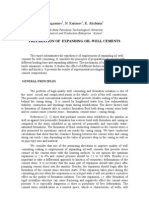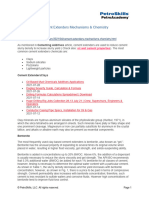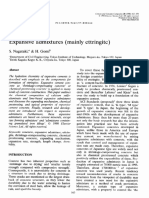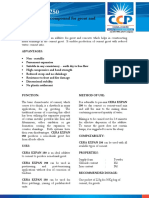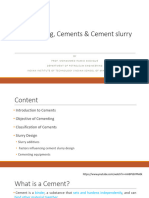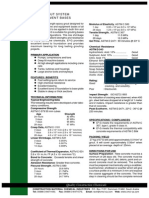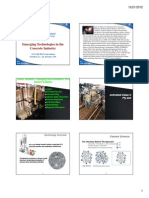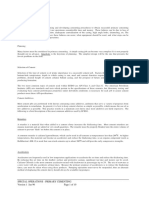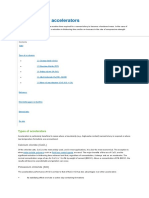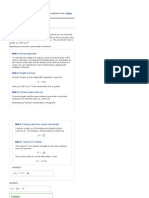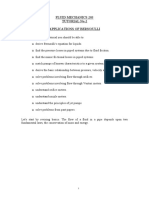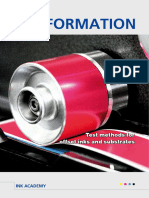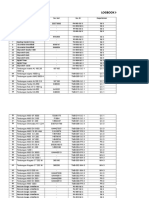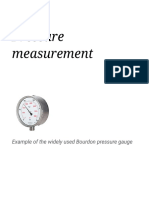Section 17 - Expansive Additives
Uploaded by
Randy BarberySection 17 - Expansive Additives
Uploaded by
Randy BarberySection 17
Cementing Technology Manual Expansive Additives
Section 17
Expansive Additives
Contents
Expansive Additives ...................................................................................................................... 17-3
Crystalline Growth ................................................................................................................... 17-3
Gas Generation....................................................................................................................... 17-3
Benefits of Expanding Cement ............................................................................................... 17-3
EA-2 .............................................................................................................................................. 17-4
MicroBond ..................................................................................................................................... 17-7
MicroBond M ............................................................................................................................... 17-10
MicroBond HT ............................................................................................................................. 17-13
SUPER CBL ................................................................................................................................ 17-17
January 1996 17-1
Section 17
Expansive Additives
Cementing Technology Manual
Notes:
17-2 January 1996
Section 17
Cementing Technology Manual Expansive Additives
Section 17
Expansive Additives
Benefits of Expanding Cement
Expansive Additives
The primary benefit of expanding cement is better
bonding of cement to pipe and formation. A better
The two basic types of expansive additives are bond provides improved zonal isolation, reduces
postset crystalline growth and gas generation. water production, stops gas migration and produc-
Expansive additives have been developed to be tion, and helps protect casings from corrosive
compatible with almost all cement slurries at tem- brines. Expansive cements may also improve con-
peratures ranging from 40°F to 600°F. finement of stimulation treatments and reduce the
microannulus effect.
Crystalline Growth The cements and additives shown in Table 17-1 on
Page 17-5 provide a variety of expanding cement
Crystalline expansion is caused by crystals growing compositions that can be used to improve cement
within the cement after it has developed some com- bonding to pipe and formation.
pressive strength. This crystalline growth forces the
cement molecules apart and causes the cement to Salt-saturated cement slurries can present problems
expand. or mixing difficulties when used in combination
with CFR-2 and low fluid-loss additives. Salt satura-
The amount of expansion obtained from a crystal- tion can also affect the strength of cement.
line growth additive can vary depending on tem-
perature, the amount of additive, curing time, and An effective additive for increasing the expansion of
cement slurry composition. Because temperature high sulfate resistant (0% C3A) Class C cements is a
has a great affect on the crystaline expansion, dif- combination of 5% EA-2 and 3% aluminum sulfate,
ferent additives are required at different tempera- Al2(SO4)3. This composition should be mixed with
ture ranges. 8.8 gal (33.3 L) of water/sk for a slurry weight of
13.6 lb/gal (1.63 kg/L).
Gas Generation
Gas-generated expansion occurs before the cement
sets. Expansion is obtained when the additive pro-
duces microsize bubbles of gas. The liberation of
this gas produces an expansive force within the
unset cement. This expansion compensates for any
volume decrease caused by fluid loss or hydration
volume reduction. Gas-generated expansion also
increases the pressure of the cement against the pipe
and borehole. The amount of additive used depends
primarily on the hydrostatic pressure of the slurry
after placement. Temperature has very little effect
on gas expansion additives.
January 1996 17-3
Section 17
Expansive Additives
Cementing Technology Manual
EA-2
Description and Primary Function: EA-2 is an
expansive additive that provides postset expansion
in high C3A (tricalcium aluminate) cements. Ex-
panding cement provides improved bonding to
pipe and formation and reduces the chance of
developing a microannulus.
Secondary Effects: EA-2 can cause slurry gelation
and rapid initial set.
Safety and Handling Procedures: Avoid contact
with skin and eyes. Avoid creating and inhaling the
dust. Flush the exposed area with plenty of water.
Properties:
Additive: EA-2
Part No.: 890.50131
Specific Gravity: 2.70
Form: powder
Color: white
How Packaged: 100-lb sk
Bulk Density: 75 lb/cu ft
Water Requirement: 0.5 gal/3% BWOC, 0.8 gal/6%
bwoc
Absolute Volume: 0.0444 gal/lb
Solubility in Water: @ 20°C, 0.3g/100 ml H20
Odor: none
Flash Point: none
Normal Range of Use in Wells:
Temperature: 60°F to 170°F (16°C to 77°C) BHST
Concentration: 3 to 5% BWOC
Special Information:
Effect on Slurry Properties:
1. increases viscosity and expansion
2. decreases density and thickening time
17-4 January 1996
Section 17
Cementing Technology Manual Expansive Additives
Table 17-1: Expanding Cements
Curing Linear Expansion - (%)
Water Temp. Curing Pressure Curing Time - Days
gal/sk (L/sk) °F (°C) psi (mPa) 1 3 7 14 28
Standard Cement
5.2 (19.7) 80 (27) Atmos. 0.019 0.030 0.044 0.055 0.065
5.2 (19.7) 110 (43) Atmos. 0.010 0.022 0.030 0.034 0.042
Standard Cement + 18% Salt
5.2 (19.7) 100 (38) Atmos. 0.006 0.037 0.069 0.098 0.120
Standard Cement, Salt Saturated
5.2 (19.7) 80 (27) Atmos. 0.034 0.082 0.111 0.128 0.148
5.2 (19.7) 110 (43) Atmos. 0.049 0.078 0.094 0.113 0.137
Standard Cement + 5% EA-2 (Cal-Seal)
5.2 (19.7) 80 (27) Atmos. - - 0.221 0.242 0.267
5.4 (20.4) 80 (27) Atmos. - - 0.123 0.141 0.158
Standard Cement + 5% EA-2 + 18% Salt
5.4 (20.4) 80 (27) Atmos. - - 0.143 0.173 0.197
Standard Cement + 5% EA-2, Salt Saturated
5.4 (20.4) 80 (27) Atmos. - - 0.134 0.157 0.173
Standard Cement + 1.0% CFR-2 - Densified to 17.0 lb/gal (2.04 kg/L)
3.78 (14.31) 80 (27) Atmos. - - 0.050 0.072 0.088
Standard Cement + 0.9 gal LA-2/sk (3.4 L/sk)
5.2 (19.7) 80 (27) Atmos. - - 0.072 0.088 0.104
Premium Plus Cement (C 3 A = 0%)
7.6 (28.8) 80 (27) 1,000 (6.90) 0.013 0.017 0.021 0.027 0.027
Premium Plus Cement (C3 A = 0%) + 18% Salt
7.6 (28.8) 80 (27) Atmos. - - 0.031 0.037 0.041
Premium Plus Cement (C 3 A = 0%) + 4% Bentonite + 18% Salt + 0.75% CFR-2
10.3 (39.0) 80 (27) 1,000 (6.90) 0.010 0.019 0.030 0.033 0.038
Premium Plus Cement (C3 A = 0%), Salt Saturated
7.6 (28.8) 80 (27) Atmos. - - 0.024 0.030 0.035
Premium Plus Cement (C 3 A = 0%) + 5% EA-2
6.3 (23.8) 80 (27) 1,000 (6.90) 0.023 0.030 0.042 0.049 0.058
January 1996 17-5
Section 17
Expansive Additives
Cementing Technology Manual
Table 17-1: Expanding Cements (cont.)
Curing Linear Expansion - (%)
Water Temp. Curing Pressure Curing Time - Days
gal/sk (L/sk) °F (°C) psi (mPa) 1 3 7 14 28
Premium Plus Cement (C 3 A = 0%) + 5% EA-2 + 3% Aluminum Sulfate
8.5 (32.2) 80 (27) 1,000 (6.90) 0.040 0.108 0.124 0.127 0.131
Premium (Fine) Cement
5.0 (18.9) 95 (35) 800 (5.51) 0.004 0.009 0.014 0.019 0.023
Premium Cement + 18% Salt
4.5 (17.0) 95 (35) 800 (5.51) 0.016 0.043 0.060 0.071 0.075
Premium Cement + 3% EA-2
5.0 (18.9) 95 (35) 800 (5.51) 0.021 0.043 0.052 0.060 0.063
Premium Cement + 6% EA-2
6.3 (23.8) 95 (35) 800 (5.51) 0.029 0.091 0.116 0.129 0.135
POZMIX® A Cement - 2% Bentonite
5.75 (21.8) 80 (27) Atmos. 0.028 00.048 0.067 0.084 0.102
5.75 (21.8) 110 (43) Atmos. 0.033 0.053 0.070 0.075 0.081
5.75 (21.8) 170 (77) 3,000 (20.69) - 0.002 0.035 0.043 0.047
POZMIX A - 2% Bentonite + 10% Salt
5.75 (21.8) 80 (27) Atmos. 0.012 0.029 0.054 0.070 0.092
POZMIX A - 2% Bentonite + 18% Salt
5.75 (21.8) 80 (27) Atmos. 0.015 0.035 0.056 0.074 0.098
POZMIX A - 2% Bentonite + Salt Saturated
5.75 (21.8) 80 (27) Atmos. 0.048 0.070 0.100 0.122 0.143
5.75 (21.8) 110 (43) Atmos. 0.030 0.072 0.106 0.128 0.137
5.75 (21.8) 170 (77) 3,000 (20.69) - 0.068 0.117 0.140 0.148
Halliburton Light Cement - with Premium Plus Cement (C 3 A + 0%)
10.6 (40.1) 80 (27) 1,000 (6.90) 0.014 0.031 0.036 0.042 0.053
17-6 January 1996
Section 17
Cementing Technology Manual Expansive Additives
Activity: 100%
MicroBond
Normal Range of Use in Wells:
Description and Primary Function: MicroBond is Temperature: 60°F to 170°F (60°F to 130°F opti-
an expansive, low-temperature crystalline-growth mum) BHST
additive. It contains a blend of all the necessary Concentration: 5 to 15% BWOC
materials needed to provide low-temperature ex-
pansion. MicroBond can be used with all Portland Special Information:
cements independent of their C3A (tricalcium alu-
minate) content. MicroBond can provide more Effect on Slurry Properties:
expansion in lower strength cements, such as 50:50 1. accelerates setting and thickening time
POZMIX® blends. MicroBond can be used to pro-
vide expansion in bottomhole temperatures below 2. increases viscosity
170°F, and optimum performance is achieved below
130°F. Concentrations of 5 to 10% of this additive
are recommended for cooler temperatures, and 10 to
20% at the higher end of the temperature range. Salt
may improve the performance of MicroBond, but
laboratory research has shown that it will be benefi-
cial only at 115°F or lower. If high salt concentra-
tions are needed in a particular cementing
application, special formulations have been devel-
oped for slurries with salt concentrations up to
saturation.
Secondary Effects: MicroBond accelerates the set-
ting time and increases the viscosity of the slurry.
Interaction with Other Additives: Sodium citrate,
HALAD®-9 or HR® retarders can be used to re-
tard the set.
Safety and Handling Procedures: MicroBond can
cause slight irritation to eyes and skin and can be
irritating if inhaled. Use precautions normal to
working with dusting materials.
Properties:
Additive: MicroBond
Part No.: 516.00226
Specific Gravity: 3.20
Form: powder
Color: light pink
How Packaged: 50-lb sack
Bulk Density: 59.40 lb/cu ft
Water Requirement: not determined
Solubility in Water: 40%
Odor: odorless
January 1996 17-7
Section 17
Expansive Additives
Cementing Technology Manual
Table 17-2: MicroBond at 80°F
®
50-50 POZMIX A - Standard
Standard Cement
Cement, 2% Gel with Salt at
with Salt at 80°F
80°F
A B C D E F G H
Formulation (%bwc)
MicroBond 8.2 8.2 11.5 11.5 8.2 8.2 11.5 11.5
®
HALAD -4 0.4 0.4 0.4 0.4 0.4 0.4 0.4 0.4
Dispersant 0.51 0.51 0.6 0.6 0.51 0.51 0.6 0.6
Salt 2.14 2.14 3.0 3.0 2.14 2.14 3.0 3.0
Calcium Chloride 0 2.0 0 2.0 0 2.0 0 2.0
Water 50 50 51.6 51.6 61 61 62.6 62.6
Slurry Properties
Density (lb/gal) 15.5 15.6 15.5 15.6 14.19 14.21 14.21 14.25
3
Yield (ft /sk) 1.30 1.31 1.34 1.35 1.37 1.38 1.41 1.42
a
Initial Consistency (Bc) 10 6 7 7 2 2 2 2
15 Min Consistency (Bc) 20 17 22 13 6 5 5 6
Expansion (% Linear)b
1 Day 0.13 0.19 0.18 0.33 0.17 0.19 0.22 0.22
3 Day 0.16 0.31 0.24 0.44 0.33 0.47 0.78 0.90
28 Day 0.26 0.33 0.36 0.64 0.45 0.52 1.27 1.46
UCA Compressive
Strengths
Initial Set (hr:min) 4:09 7:26 8:33 8:02 8:14 8:00 8:04 8:01
24 Hour (psi) 2,100 1,800 1,800 1,600 300 380 420 270
3 Day (psi) 3,750 3,300 3,100 2,500 750 550 860 550
7 Day (psi) 4,640 4,130 4,400 3,700 1,750 1,020 1,900 1,110
a
Atmospheric Consistometer, 80°F
b
Water Bath, Unrestrained
17-8 January 1996
Section 17
Cementing Technology Manual Expansive Additives
Table 17-3: MicroBond at 100 and 125°F
Premium Cement
at 100°F at 125°F
A B C D E
Formulation (%bwc)
MicroBond 10.8 10.8 6.5 10.8 10.8
®
HALAD -322 0.6 0.6 0.6 0.6 0.6
a
Salt 5.0 None None 5.0 None
Calcium Chloride 1.0 1.0 1.0 1.0 1.0
Water 50 49 48 50 50
Slurry Properties
Density (lb/gal) 15.8 15.6 15.5 15.7 15.5
3
Yield (ft /sk) 1.33 1.31 1.20 1.33 1.30
b
Initial Consistency (Bc) 5 4 3 3 3
10 Min Consistency (Bc) 6 7 5 3 3
30 Min Consistency (Bc) 6 7 5 5 7
Expansion (% Linear), 100°F
1 Day 0.37 0.31 0.20 0.13 0.19
3 Day 0.39 0.71 0.25 ND ND
7 Day 0.41 1.33 0.27 0.14 0.23
a
10% bww
b
Atmospheric - 101°F
January 1996 17-9
Section 17
Expansive Additives
Cementing Technology Manual
Concentration: 5% bwoc
MicroBond M Special Information:
Effect on Slurry Properties: slight acceleration of
Description and Primary Function: MicroBond M thickening time
is a postset crystalline-growth expansive additive
that provides good expansive properties at tem-
peratures ranging from 130°F to 210°F BHST. At
dosage levels of only 5%, MicroBond M will pro-
vide good expansive properties in virtually any
cement system. MicroBond M has been tested in
slurries containing 12% to 37% salt and has per-
formed well in temperatures between 170°F and
210°F. MicroBond M will yield good expansion in 3
days.
Secondary Effects: MicroBond M provides some
acceleration of slurry thickening time and cement
setting time.
Interaction with Other Additives: If MicroBlock or
Silicalite additive is in the slurry, more MicroBond
M will be required to obtain the same amount of
expansion. High concentrations of sodium chloride
will retard the expansion reaction and increase the
temperature range.
Safety and Handling Procedures: MicroBond M
dust may cause a mechanical irritation to the eyes.
Excessive inhalation above the PEL of mineral dust,
over long periods of time, may cause industrial
bronchitis, reduce breathing capacity, and lead to
increased susceptibility to other lung disease.
Properties:
Additive: MicroBond M
Part No.: 516.00513
Specific Gravity: 3.6
Form: powder
Color: tan to dark brown
How Packaged: 50-lb sack
Bulk Density: 65.0 lb/cu ft
Water Requirement: not determined
Solubility in Water: @ 20°C, 0.0062g/100ml H20
Odor: odorless
Activity: 100%
Normal Range of Use in Wells:
Temperature: 130°F to 210°F BHST
17-10 January 1996
Section 17
Cementing Technology Manual Expansive Additives
Table 17-4: MicroBond M Test Slurries
Slurry No. 1 Slurry No. 2 Slurry No. 3 Slurry No. 4 Slurry No. 5 Slurry No. 6
Component Percent Percent Percent Percent Percent Percent
Premium Cement 100 100 100 100 100 100
SSA-1 0 35 0 0 0 35
Salt 0 0 12 18 Sat'd 34.8
MicroBond M 5 5 5 5 5 5
®
HALAD -322 0.5 0.5 0 — — —
HALAD-413 0 0 0.5 0.5 0.5 0.5
HALAD-24 — — — 0 0 0.5
®
HR -5 variable 0.2 0 0 0.2 0
CFR-3 — — — 0 0 0.2
Water 38.1 51.4 38.1 38.1 38.1 57.6
Table 17-5: MicroBond M Expansion Data
Curing Expansion
Slurry Temp 3 Day 7 Day 14 Day
No. (%) (%) (%) (%)
a
1 95 0.14 0.18 0.27
a
1 110 0.17 0.21 0.28
b
1 130 0.21 0.54 1.21
b
1 150 0.13 0.68 1.45
1 170 — 1.30 —
b
1 190 0.39 0.5 0.46
b
1 210 0.36 0.44 0.37
a
2 240 0.31 0.30 —
3 150 0.40 0.84 1.27
4 150 0.30 0.58 1.02
c
5 150 0.42 0.56 0.61
6 275 0.49 0.51 —
a
Actual measurements made after 4 days.
b
Actual measurements made after 15 days.
c
Actual measurements made after 2 days.
January 1996 17-11
Section 17
Expansive Additives
Cementing Technology Manual
Table 17-6: Microbond M Thickening Time*
®
Temp HR -5 Thickening Time
(°F) (%) (Hr:Min)
95 0 7:03
110 0 5:43
120 0.1 6:04
130 0.2 6:21
*Slurry No. 1
Table 17-7: Microbond M Compressive Strength*
UCA Compressive Strength
Test Temp HR-5 Initial Time to Reach
(°F) (%) Set 500 psi 24 Hour 72 Hour
(Hr:Min) (Hr:Min) (psi) (psi)
95 0 7:29 10:37 2,500 4,200
110 0 6:00 8:33 2,850 4,300
130 0 5:14 6:52 2,866 4,125
150 0 4:38 5:55 2,772 3,925
200 0.1 5:21 6:16 3,175 3,559
210 0.2 3:18 4:01 3,550 3,890
a
240 0.2 2:14 3:11 3,250 3,975
*Slurry No. 1, Pressure - 3,000 psi
a
Slurry No. 2 used.
17-12 January 1996
Section 17
Cementing Technology Manual Expansive Additives
Normal Range of Use in Wells:
MicroBond HT Temperature: 170°F to 400°F BHST (optimum at
temperatures greater than 210°F)
Description and Primary Function: MicroBond HT Concentration: 3 to 5% bwoc
provides expansion at temperatures above 170°F
BHST. Significant expansion can be realized in 7 to Special Information:
28 days at temperatures between 170°F and 210°F,
in 3 to 7 days at temperatures between 210°F and Effect on Slurry Properties: accelerates thickening
240°F, and in 3 days in temperatures over 240°F. time
MicroBond HT can provide 1 to 3% linear expan-
sion at concentrations of only 3 to 5% by weight of
cement. MicroBond HT is compatible with all ce-
ments and many cement additives.
Secondary Effects: MicroBond HT accelerates the
slurry thickening time.
Interaction with Other Additives: If MicroBlock or
Silicalite additive is in the slurry, more MicroBond
HT will be required to obtain the same amount of
expansion. High concentrations of sodium chloride
will retard the expansion reaction.
Safety and Handling Procedures: MicroBond HT
dust may cause a mechanical irritation to the eyes.
Excessive inhalation above the PEL of mineral dust,
over long periods of time, may cause industrial
bronchitis, reduce breathing capacity, and lead to
increased susceptibility to other lung disease.
MicroBond HT may aggravate asthma and inflam-
matory or fibrotic pulmonary disease.
Properties:
Additive: MicroBond HT
Part No.: 516.00446
Specific Gravity: 3.57
Form: powder
Color: tan
How Packaged: 50-lb sack
Bulk Density: 112.0 lb/cu ft
Water Requirement: not determined
Solubility in Water: negligible
Odor: odorless
Activity: 100%
January 1996 17-13
Section 17
Expansive Additives
Cementing Technology Manual
Table 17-8: Temperature Range for MicroBond HT Expansion at 3,000 psi*
a
Consistancy % Linear Expansion @ Curing Time
Retarders
% and Type
Initial 20 Min °F 3 Day 7 Day 14 Day 28 Day °Fb
®
0.1% HR -5 10 13 129 nil nil 1.43 2.15 170
c
0.4% HR-5 11 12 139 0.05 0.35 2.88 dis 190
c
0.4% HR-5 10 13 158 0.16 2.47 dis — 210
c
0.3% HR-5 10 13 163 2.69 dis — — 240
c
0.4% HR-5 10 12 180 2.14 dis — — 275
c
1.0% HR-12 10 14 190 2.53 dis — — 300
1.0% HR-12 with
c
0.4%Component R 10 13 190 2.35 dis — — 350
®
*Premium cement, 40% SSA-2, 0.6% HALAD -322, 4.4% MicroBond HT, Retarder as shown,
38% water
a
Halliburton Atmospheric Consistometer
b
Increase to test temperature in 4 hours after placing in pressure autoclave.
c
dis - discontinued
Table 17-9: MicroBond HT Expansion at 3,000 psi *
Retarders % Linear Expansion @ Curing Time
% and Type 3 Day 7 Day 14 Day 28 Day °F
0.1% HR-5 nil nil 1.43 2.15 170
a
0.4% HR-5 0.05 0.35 2.88 dis 190
a
0.4% HR-5 0.16 2.47 dis — 210
a
0.3% HR-5 2.69 dis — — 240
a
0.4% HR-5 2.14 dis — — 275
a
1.0% HR-12 2.53 dis — — 300
1.0% HR-12 with
a
0.4%Component R 2.35 dis — — 350
*Premium cement, 40% SSA-2, 0.6% HALAD-322, 4.4% MicroBond HT, Retarder as shown,
38% water
a
dis = discontinued
17-14 January 1996
Section 17
Cementing Technology Manual Expansive Additives
Table 17-10: MicroBond HT Dosage vs Expansion
at 275°F and 3,000 psi
MicroBond Consistency 3 Day
®
HT HR -5 Water Bc @ 180°F Expansion
(%) (%) (%) Initial 20 Min (%)
®
Premium cement, 40% SSA-2, 10% SSA-1, 0.6% HALAD -322
2.0 0.4 37.0 9 10 0.14
3.0 0.4 37.5 8 9 1.73
2.7 0.4 42.1 10 10 0.28
3.6 0.4 41.4 8 12 1.18
4.4 0.4 41.8 13 11 2.96
5.3 0.4 41.0 12 13 4.49
Premium cement, 40% SSA-2, 0.6% HALAD-322, 4.4% MicroBond HT
2.0 0.5 37.0 8 8 0.14
3.0 0.5 37.5 11 8 1.73
3.5 0.5 38.0 8 9 1.34
4.4 0.4 38.0 10 12 2.14
Table 17-11: MicroBond HT Compressive Strengths - UCA Test Results*
Static Curing Time to Reach Strength
Retarders Initial Set
Temperature 1,000 psi at 72 Hours
% bwc, Type (Hr:Min)
(°F) (Hr:Min) (psi)
a
170 (129) 0.1% HR-5 5:20 7:00 3,600
190 (139) 0.2% HR-5 7:57 9:20 3,400
210 (163) 0.3% HR-5 3:23 4:30 3,200
275 (190) 0.4% HR-5 1:10 2:00 1,600
0.7% HR-12,
300 (190) 0.4% Component R 2:00 4:15 4,300
1.2% HR-12,
350 (190) 0.8% Component R 9:30 13:50 5,100
*Premium cement, 25% SSA-2, 0.6% Halad-322, 4.0% MicroBond HT, 41.6% Water
a
Equivalent cirulating temperatures for static temperatures are shown in parentheses. Slurries
were preconditioned (20 minutes) and UCA tests were started at these temperatures and
brought to static temperature in 4 hours.
January 1996 17-15
Section 17
Expansive Additives
Cementing Technology Manual
Table 17-12: Influence of MicroBond HT on Thickening Time*
Thickening Time
Microbond HT Retarders Water BHCT a
to 70 Bc
(%) % and Type (%) (°F)
(Hr:Min)
®
None 0.25% HR -5 40 190 4:00
None 0.30% HR-5 40 190 6:00
4.0 0.25% HR-5 41.6 190 3:40
4.0 0.30% HR-5 41.6 190 4:55
1.0% HR-12,
None 0.5% Component R 40 308 8:00+
0.75% HR-12,
None 0.4% Component R 40 308 5:25
0.5% HR-12,
None 0.4% Component R 40 308 1:09
0.7% HR-12,
4.0 0.7% Component R 41.6 308 4:00
1.0% HR-12,
4.0 0.5% Component R 41.6 308 1:49
®
*Premium cement, 25% SSA-2, 0.6% HALAD -322, MicroBond HT, Retarders, Water
a
HP-HT Consistometer
17-16 January 1996
Section 17
Cementing Technology Manual Expansive Additives
Normal Range of Use in Wells:
SUPER CBL
Temperature: 60°F to 400°F (16°C to 204°C) BHST
Concentration: 0.15 to 0.6%
Description and Primary Function: SUPER CBL is
used to help prevent gas migration in wells with Special Information:
low to severe gas flow potentials. It liberates a gas
on reacting with the cement slurry and increases Usage Restrictions: Do not use SUPER CBL in a
the compressibility of the slurry. It is also used to slurry than contains more than 18% salt.
improve the bond of cement to pipe and formation
Effect on Slurry Properties:
by causing the cement to expand before it sets.
1. accelerates
Secondary Effects: SUPER CBL can accelerate the
slurry and can cause gelation during thickening. 2. can cause some gelation
Safety and Handling Procedures: SUPER CBL
liberates a highly flammable gas. Use only in well-
ventilated areas. “No Smoking” policies must be
strictly enforced. Storing slurry samples containing
SUPER CBL is very dangerous if they are kept in a
confined vessel. The resulting pressure buildup
can cause the container to explode. If a SUPER
CBL slurry is circulated back to surface, it should
be disposed of in an open pit as far from working
areas as possible. When drilling out SUPER CBL
cement, it is recommended that the drilling fluid
pass through a gas separator equipped with a
flame arrestor before going to a shale shaker if the
blooey line is equipped with a pilot or ignition
plug. If no flame arrestor is used, extinguish the
pilot or completely bypass the gas separator.
Properties:
Additive: SUPER CBL
Part No.: 516.00223
Specific Gravity: 2.6
Form: powder
Color: gray metallic
How Packaged: 50-lb drums
Bulk Density: 56.9 lb/cu ft
Water Requirement: none
Absolute Volume: 0.0462 gal/lb
Solubility in Water: @ 20°C, insoluble
Odor: slight
Activity: 97%
January 1996 17-17
Section 17
Expansive Additives
Cementing Technology Manual
Table 17-13: SUPER CBL Expansion Data
Percent Volume Expansiona for lb SUPER CBL/sk
b 1 1 3 1 5 3
Ft /8 lb /4 lb /8 lb /2 lb /8 lb /4 lb
2,000 0.92 1.8 2.7 3.7 4.6 5.5
4,000 0.58 1.2 1.7 2.3 2.9 3.5
6,000 0.42 1.0 1.2 1.6 2.1 2.5
8,000 0.33 0.67 1.0 1.3 1.7 2.0
10,000 0.26 0.52 0.78 1.0 1.3 1.6
12,000 0.21 0.42 0.63 0.84 1.1 1.3
14,000 0.18 0.35 0.53 0.71 0.88 1.1
16,000 0.16 0.33 0.49 0.65 0.81 0.98
18,000 0.16 0.31 0.47 0.62 0.78 0.93
20,000 0.15 0.29 0.44 0.58 0.72 0.87
Divide values by actual slurry yield. Values shown are for constant pressure
and temperature without volume loss from fluid loss of chemical hydration.
a 1
Based on /3 of the total reaction during plastic state.
b
API casing conditions for 1.5°/100 ft gradient.
17-18 January 1996
Section 17
Cementing Technology Manual Expansive Additives
January 1996 17-19
You might also like
- Preparation of Expanding Oil-Well Cements: F.Agzamov, N. Karimov, K. AkchurinNo ratings yetPreparation of Expanding Oil-Well Cements: F.Agzamov, N. Karimov, K. Akchurin7 pages
- Case Studies of Expanding Cement To Improve Wellbore SealingNo ratings yetCase Studies of Expanding Cement To Improve Wellbore Sealing15 pages
- 2 Classification Additives CalculationsNo ratings yet2 Classification Additives Calculations32 pages
- Cement Extenders Mechanisms Article For Reading HandoutNo ratings yetCement Extenders Mechanisms Article For Reading Handout15 pages
- Expansive Admixtures (Improve The Effect of Controling Crack Propagation)No ratings yetExpansive Admixtures (Improve The Effect of Controling Crack Propagation)8 pages
- Expansive Additives For Structural GroutNo ratings yetExpansive Additives For Structural Grout6 pages
- Cement Additives (Function and Definition)No ratings yetCement Additives (Function and Definition)3 pages
- Unit 6 Cementing, Cements and Cement SlurryNo ratings yetUnit 6 Cementing, Cements and Cement Slurry91 pages
- Cmci Cmci: Epoxy Grout System For Equipment BasesNo ratings yetCmci Cmci: Epoxy Grout System For Equipment Bases2 pages
- Drilling Methods II - PGG 324 - Week 7 - CementingNo ratings yetDrilling Methods II - PGG 324 - Week 7 - Cementing76 pages
- Cmci Cmci: High Performance Epoxy Grout SystemNo ratings yetCmci Cmci: High Performance Epoxy Grout System2 pages
- Emerging Technologies in The Concrete IndustryNo ratings yetEmerging Technologies in The Concrete Industry5 pages
- Circular Expansion Cement Curing Kit Instruction Manual: Manual No. 101443617, Revision C Instrument No. 205814No ratings yetCircular Expansion Cement Curing Kit Instruction Manual: Manual No. 101443617, Revision C Instrument No. 20581419 pages
- Oil Well Cement: Submitted By-Kajal Gangil BARN1AR130026No ratings yetOil Well Cement: Submitted By-Kajal Gangil BARN1AR13002612 pages
- Cement Additives and Mechanisms of ActionNo ratings yetCement Additives and Mechanisms of Action55 pages
- SaueResisen-EPOXY EXPANSION JOINT COMPOUNDSNo ratings yetSaueResisen-EPOXY EXPANSION JOINT COMPOUNDS2 pages
- Non-Shrink Grout Additive: Specification For Specification ForNo ratings yetNon-Shrink Grout Additive: Specification For Specification For2 pages
- Additives Brochure EN Apac 20130801 Page PDFNo ratings yetAdditives Brochure EN Apac 20130801 Page PDF6 pages
- EDKB1103e - Construction Chemicals IndustryNo ratings yetEDKB1103e - Construction Chemicals Industry6 pages
- Alkali Silica Reaktion (ASR - ASTM C 1567)No ratings yetAlkali Silica Reaktion (ASR - ASTM C 1567)67 pages
- Accumulator Capacity - Usable Volume Per BottleNo ratings yetAccumulator Capacity - Usable Volume Per Bottle2 pages
- Water Conveyance With Syphons: September, 2000 (Rev 2009)100% (1)Water Conveyance With Syphons: September, 2000 (Rev 2009)19 pages
- Multifunctional Expansion Tanks CatalogNo ratings yetMultifunctional Expansion Tanks Catalog75 pages
- Fluid Mechanics 203 Tutorial No.2 Applications of Bernoulli100% (1)Fluid Mechanics 203 Tutorial No.2 Applications of Bernoulli37 pages
- Negative Slip, Flow Separation Conditions, Air VesselsNo ratings yetNegative Slip, Flow Separation Conditions, Air Vessels7 pages
- Silo - Tips Test Methods For Offset Inks and SubstratesNo ratings yetSilo - Tips Test Methods For Offset Inks and Substrates28 pages
- Engineering Encyclopedia: Centrifugal Pumps80% (5)Engineering Encyclopedia: Centrifugal Pumps70 pages
- Pipeline Pressurisation & de Pressurisation Calculation50% (2)Pipeline Pressurisation & de Pressurisation Calculation4 pages
- Chapter 03 Gas Properties Recitation QuestionsNo ratings yetChapter 03 Gas Properties Recitation Questions4 pages

